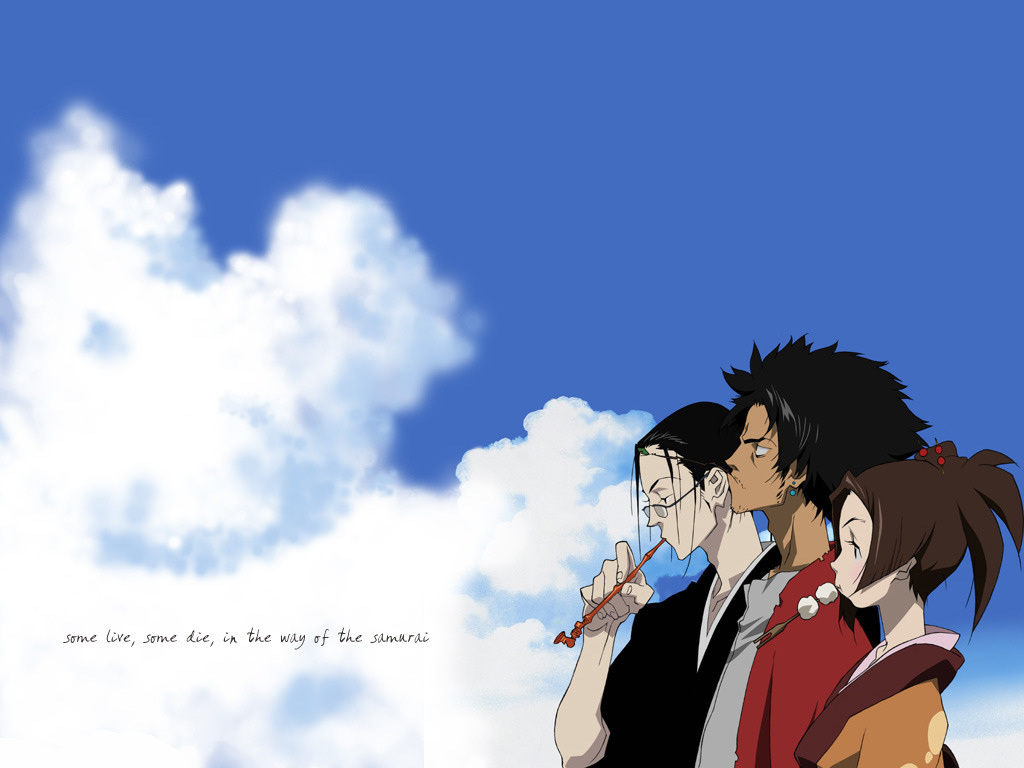Jin: Well said, I agree with him.
Genres: Action, Comedy, Chanbara
Creator: Shinichiro Watanabe
Studio: Manglobe
Length: 26 episodes
Year: 2004
Highlights: Samurai, Hip-hop music, and ninja baseball
In feudal Japan there lives a young waitress named Fuu. Her life is mostly boring and uneventful until one day when two strange men wander into her restaurant. The first is a vagrant swordsman; brash, reckless, and totally fearless. His name is Mugen. The second is a mysterious ronin; stoic, composed, and elegant. His name is Jin. Both are master warriors and consider the other a worthy opponent. They begin a duel to the death but are arrested before they conclude their fight. After being saved from certain death by Fuu, they agree to travel with her on her quest in order to find “the samurai who smells of sunflowers.”
Like Cowboy Bebop, Samurai Champloo is a mix and match of different influences that you would not normally expect to find together. Appropriately, the title translates to “Samurai Remix”, or “Samurai Mashup”. The show is set the Edo era of Japanese history (sometime between 1603 and 1868); the exact time is purposely inexact, and the characters will often reference events centuries apart as if both occurred recently. The show is heavily based off Chanbara films; that is, samurai films. However, the film also draws heavily from modern hip-hop music and culture. The show features such odd combinations as beat-boxing samurai, blood feuds settled by graffiti contests, and sword fighting merged with break dancing. Both the English dub and the original Japanese audio feature heavy use of modern slang and English-derived words. The genre mixing is not as pronounced as Bebop, but it creates a feel that is both unique and comfortably familiar at the same time.
Similar to Watanabe’s earlier work, Samurai Champloo consists of mostly self-contained episodes, although there is an overarching plot detailing Fuu, Jin, and Mugen’s search for the sunflower samurai. In addition, there are a number of multi-part episodes showing extended stories. All of the main characters’ pasts are revealed slowly, but for the most part they do not play a major role in the plot. Also like Bebop, Champloo’s tone switches back and forth from serious to comedic, although it is generally heavier on the latter element. The show’s anachronism shows up here as well, most notably in an episode where our heroes get involved in a baseball game. Of course, this being feudal Japan, none of them actually know how to play the game. So instead, it devolves into extremely violent NINJA baseball. And it is hilarious.
A heavy incorporation of music is one of Watanabe’s trademarks. Appropriately, Samurai Champloo has a wonderful hip-hop soundtrack comprised of primarily Japanese artists. Included here are artists such as Tsutchie, Force of Nature, and the late Nujabes. Some of my favorites include the opening song by Nujabes (“Battlecry”), the closing song by Minmi (“Shiki no Uta”, or “Song of Four Seasons”), and “Fly” by Tsutchie. But in keeping with its anachronistic feel, the series also includes a large amount of traditional Japanese music. Some gems are “Obokuri-Eeumi” by Okinawan artist Ikue Asazaki and “Kuzunoha no Kowakare” by Tsukioka Yukiko.
Although they may seem like an unappetizing mix, hip-hip culture and samurai actually go together quite well. Shinichirō Watanabe has once again shown his skill in throwing together strange genres and influences to create something new and engaging. This is not the last time that we will cross paths with Watanabe, but until then journey for a while with Mugen, Jin, and Fuu. Take in the Japanese countryside, the hip-hop music, and the sunflowers.

 RSS Feed
RSS Feed
